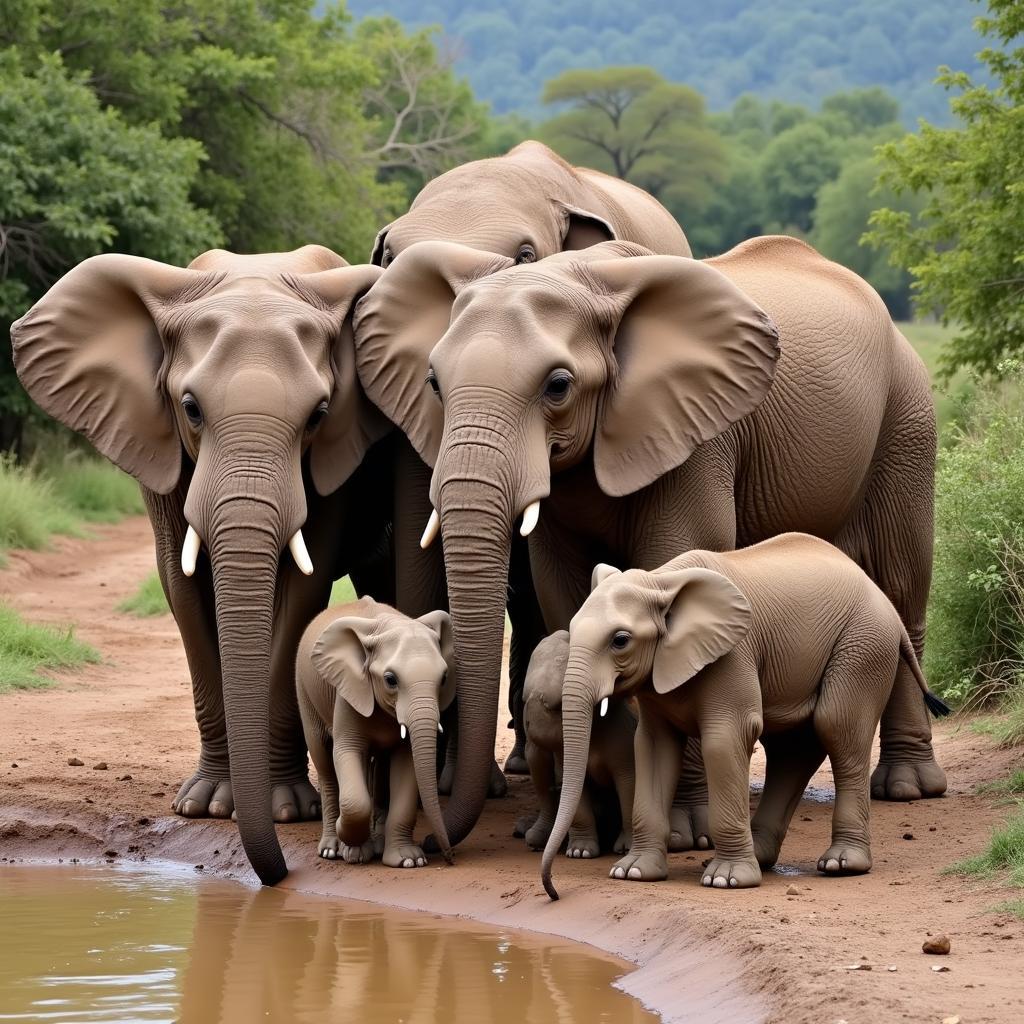Uncovering Fascinating African Elephant Facts: A Deep Dive into Their World
African elephants are iconic symbols of this vast and diverse continent, captivating hearts with their sheer size, intelligence, and complex social structures. But how much do you really know about these gentle giants? This article delves into captivating African elephant facts, giving you a deeper understanding of their lives and the challenges they face.
Unveiling the Giants: Two Distinct Species
While often spoken of as one, “African elephants” actually encompass two distinct species: the African bush elephant (Loxodonta africana) and the African forest elephant (Loxodonta cyclotis). These majestic creatures, while sharing a common ancestor, possess unique characteristics that set them apart.
African Bush Elephant: The Larger-Than-Life Nomad
Towering over the African savanna, the African bush elephant rightfully claims the title of the largest land animal on Earth.
- Imposing Size: Adult males can reach a shoulder height of up to 3.3 meters (11 feet) and weigh up to 6,000 kilograms (13,200 pounds)! Females are slightly smaller but still incredibly imposing.
- Distinctive Features: Bush elephants are distinguished by their larger size, concave back, and larger ears that resemble the shape of the African continent. Their tusks, present in both males and females, are more prominent and curve outwards.
- Habitat and Range: These giants roam the open savannas, grasslands, and woodlands of sub-Saharan Africa, covering vast distances in search of food and water.
 African bush elephant walking across the savanna
African bush elephant walking across the savanna
African Forest Elephant: Guardians of the Congo Basin
In the dense rainforests of Central Africa, the smaller, more elusive African forest elephant thrives.
- Adapted for the Forest: Their smaller stature and straighter tusks allow them to navigate the dense vegetation of their rainforest home.
- Crucial Role in the Ecosystem: Forest elephants are true ecosystem engineers, creating clearings and dispersing seeds as they move through the forest, shaping the very environment they inhabit.
- Conservation Concerns: Facing threats from habitat loss and poaching, these forest giants are critically endangered, highlighting the urgent need for their protection.
A Day in the Life: Social Butterflies and Devoted Mothers
African elephants are highly social animals, living in tightly-knit family groups led by an experienced matriarch, often the oldest and wisest female.
- Matriarchal Society: The matriarch guides her family group, making crucial decisions about feeding grounds, water sources, and migration routes.
- Communication is Key: Elephants communicate through a complex language of rumbling sounds, trumpets, and rumbles, some of which are infrasonic – too low for humans to hear! These sounds travel for miles, allowing communication across long distances.
- Raising the Next Generation: Calves are raised collectively within the herd, with females sharing the responsibility of nurturing and protecting the young.
 African elephant family group gathered around a waterhole
African elephant family group gathered around a waterhole
More Than Just Trunks and Tusks: Surprising African Elephant Facts
Beyond their impressive size and social dynamics, there’s much more to learn about these magnificent creatures:
- Trunk Tales: An elephant’s trunk is a marvel of evolution, a fusion of the nose and upper lip with over 40,000 muscles! It’s used for breathing, smelling, trumpeting, drinking, and delicately grasping objects.
- Tusks for Life: An elephant’s tusks are actually elongated incisor teeth that grow throughout their lifetime. They serve multiple purposes, from digging for water and stripping bark to defense and displays of dominance.
- Intelligence on Display: Elephants are highly intelligent animals, with excellent memories and problem-solving abilities. They exhibit a wide range of emotions, including grief, joy, and compassion.
The Future of African Elephants: A Call to Action
Despite their size and strength, African elephants face a myriad of threats, primarily from human activities:
- Poaching for Ivory: The illegal ivory trade continues to decimate elephant populations.
- Habitat Loss and Fragmentation: As human populations grow, elephant habitats are lost to agriculture, infrastructure development, and resource extraction.
- Human-Elephant Conflict: As elephants lose their habitats, they are increasingly coming into conflict with humans, leading to crop raiding and other challenges.
Protecting these magnificent creatures requires a multi-faceted approach, including:
- Strengthening Anti-Poaching Efforts: Increased law enforcement, better border controls, and tougher penalties for poachers are crucial to curb the illegal ivory trade.
- Expanding and Connecting Habitats: Establishing wildlife corridors and protecting existing habitats are essential to ensure elephants have access to the resources they need to thrive.
- Promoting Sustainable Coexistence: Finding ways for humans and elephants to share space peacefully is vital.
Conclusion: Ensuring a Future for African Elephants
Learning about African elephant facts is not just about appreciating their grandeur; it’s about understanding the crucial role they play in their ecosystems and recognizing the urgent need for their conservation. By supporting conservation efforts, promoting responsible tourism, and spreading awareness, we can all contribute to securing a future for these magnificent giants, ensuring they continue to roam the African landscape for generations to come.

